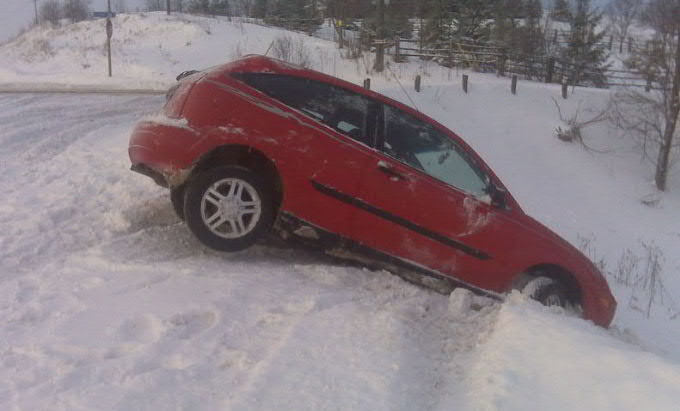
The Boy Scouts had it right: be prepared! Ski season means you’re going to be spending a lot of money and time on your trips to the mountains, and there’s nothing LESS fun than breaking down or getting into an accident on the way. A few simple preparations can make your trip safer, lower stress, and give you more time to enjoy the amenities at the mountain (you’d hate to arrive after the bars close Friday night because your car broke down, wouldn’t you???). Here’s our tips to help you minimize your risk.
Prepare Your Car For Winter Driving: The “Walkaround”
Take a look at the outside of your car. Check all of your tires. Are they inflated correctly? Hint: late model cars will have a sticker on the driver’s door jamb that gives recommended pressure. Invest in a good tire gauge (my favorite for cheap money is the Accutire Digital Pencil, available from Tire Rack for a whole $8.95) and keep it in your car. Look at the sidewalls…any cuts or bulges visible? Do they have plenty of tread? Remember, if you’re lucky you’re going to be driving in snow, so “enough” means a lot more than “will pass inspection”(if you’re unsure about whether your tires are right for your trip, check out “Snow Sneakers“). Next, look at your windshield wipers. Even if you live in the South, think about investing in a set of winter blades for your trip. They’re pretty cheap, and have a rubber boot that covers the whole blade/spring mechanism, making them ice up a lot less. Blades are easy to change, so you can switch the winter ones back on for every trip.
While you’re at it, fill up your windshield washer fluid reservoir. If you haven’t driven in snow before, you’ll be amazed at how much filthy gunk the car in front of you throws up. You’ll use more fluid than you could imagine. Again, if you’re from farther south, be careful…you may only be able to buy “summer” fluid. If that’s the case, as soon as you get farther north, pull over at a gas station and buy some winter fluid. The summer stuff WILL freeze up in some conditions, rendering it useless. Put it in and refill regularly so you don’t run out while you’re driving. Yes, carry an extra bottle of the stuff in the back…you will ALWAYS run out of it in the middle of a slushy mess 20 miles from any place to buy it!
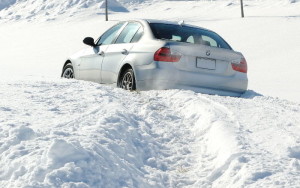
Don’t forget that if your car has a rear wiper, it will probably have its own reservoir. Check that wiper, too, and fill that reservoir. You may not need them often, but if you do slide into a snowbank, you’ll want to try to back out (assuming you have those good tires). But, if you can’t see where you’re going and what’s coming up behind you, it may be too dangerous to try. There’s another advantage to having that system working well, too. More than once, I’ve seen someone going out of control behind me (yeah, they DIDN’T have good tires) and was able to react and avoid an accident.
If you’re really serious about being ready, buy some Simoniz S14 Aquapel and put it on your windshield. It’s a minor pain in the neck, but it makes an incredible difference to your vision. Rain beads up, reducing the “halo” effect, and your wipers work a lot more effectively, and at highway speeds rain will literally blow off your windshield. I used to pay $25 to have the local Midas shop put it on; now it’s available in parts stores, hardware stores, or online for $10-15. A truly GREAT deal to make you safer!
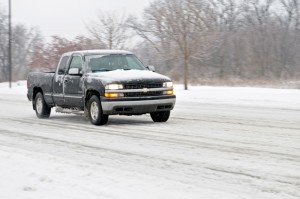
One other thing, and this will require a trip to the Napa, VIP or whatever other auto parts store is near you. Have them test your charging & cooling systems. They usually don’t charge YOU anything to do them, and that 4 year old battery that works fine at 60 degrees just might strand you in colder weather. Particularly if you’re driving up from the south, you may have no indication that your battery is getting weak; as soon as it turns cold, you’ll find out the hard way. Better to find out before you go if you’re going to have to change that battery anyway! The same goes for your coolant; if it’s low, or has the wrong mix, you could wake up in the morning to find that engine has just become a boat anchor. Hitchhiking back from your winter vacation is really difficult when you’re carrying skis…there just aren’t that many people who will pick you up.
Prepare Your Car For Winter Driving: Inside your car
Okay, this may sound silly, but wash the inside of your windows well. You just don’t notice how bad that gunk on the inside is until the most inconvenient moment…or the most dangerous one. It’ll help keep the windows from fogging up, and it’ll dramatically reduce the glare when some idiot–oh, wait, make that “attention challenged person”–forgets to put their high beams down while driving toward you (in the rain, of course). Windows and particularly windshields have always been a pain in the neck to clean, but you can now buy premoistend glass cleaning wipes at all the usual places, and they remove most of the irritation of the job.
Next, put together an emergency kit. With any luck you’ll never have to use it, but it can save your your trip, your mood, your sanity, and maybe even your life if a worst-case situation happens (you know, the ones you read about in the supermarket tabloids…”Family eats dog and father’s left arm to survive blizzard inside car.”). It doesn’t have to be elaborate, but pay attention to the key things: light, heat, calories, and water. Here’s the basic list…get it all together, find a compartment that it all fits in reasonably snugly, and put it somewhere that you can find easily in the dark without a flashlight in a snowstorm! You don’t want to have to be digging around for it if you really ARE in an emergency situation (although it’s a good idea to have a flashlight in your glove compartment, too; even if you don’t have much room, you can find a home for a small one).
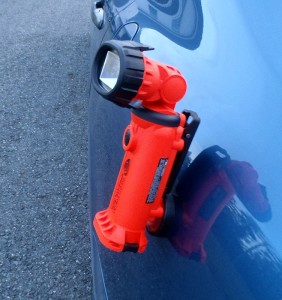
 can put light exactly where you need it (David Shedd photo)
can put light exactly where you need it (David Shedd photo)1. Flashlights. Do NOT cheap out on these; there’s nothing more frustrating than a flashlight that doesn’t work right when you need it most. For the glove compartment, get a basic LED flashlight that’s waterproof, rugged, and gives off a very bright light. Also, get one that uses AA batteries (and check them regularly). Why AA? Because if they ever DO go dead, they’re the easiest to replace on the road, and the flashlights are typically small enough to easily fit into whatever space you have. A couple of good options are the NiteCore EZ LED or the Mini Mag LED
. And yes, keep spare batteries in the emergency kit! Then, have a bright worklight in the emergency kit that you can use for more serious problems (breakdowns, getting stuck in a snowbank, whatever). Without a doubt, the most flexible and functional version of this we’ve found yet is the Streamlight Knucklehead
. With a 200 lumen beam, a strobe mode, a totally articulated head that allows you to aim it wherever you need it, a belt clip, and a rubber covered magnet so you can stick it to a fender, it’s a “do anything” light (ask us about how it saved Thanksgiving by doubling as a headlight for a tractor!). Yes, it uses AAs, too…and it’s available in a rechargeable model that you can permanently mount in the car so it’s ALWAYS there and ready for you. Pricey? Yes, but if you can swing it, it’s worth it. If not, look for a light that can be placed in a spot and stay put; round and rolling isn’t a good thing.
2. Heat source. There’s two parts to this: something to burn, and something to light it with. My favorite heat source is one of those cute little candle lanterns that are designed for camping. It saves your flashlight batteries, it’s bright enough to read by, and it produces an amazing amount of heat in the enclosed space of a car. Also, they’re inexpensive and easily available (try REI or EMS). The flame is somewhat enclosed, making them a lot safer than an open stove. As for how to light it, think redundant. Have a lighter and some waterproof matches so that if the lighter feels like breaking down, you’ve got a backup. For the lighter, a standard barbeque grill stick lighter works best…you’ll burn your fingers with a cigarette lighter. Bic makes one that folds up and designed for candles; it’s perfect. Waterproof matches…Coghlan’s makes them, and you can buy them cheap at Campmor. Buy a bulk package of them and put boxes in everyone’s Christmas stocking. Practice lighting the lantern before you put it away in the kit; sometimes, it’s hard to find the lighting hole, and you’ll probably be doing this in dark, cold, miserable conditions. As morbid as it seems, have other people in your group try it, too…you might not be the one who’s doing the lighting, for unpleasant reasons.
3. Waterproof gloves. Some people will say mittens, since they’re warmer. I like gloves, since I have better dexterity in them, and since you’ll have your ski gear with you, if things get really bad you’ll be putting all of that stuff on. I’m not talking high-tech here…I’m talking about something you can throw on when you need to crawl under the car to dig snow and ice out, that wil keep your hands dry and acceptably warm. Get a pair with some insulation and a knit cuff, not gauntlet style; you want the snow and ice staying out of them when you’re digging around. Don’t spend too much, so you won’t care if you ruin them. Kinco work gloves are the standard for Ski Patrollers every and are a great choice.
4. Calories. No, you can’t put chocolate in…sorry. It melts and makes a heck of a mess and is hard to deal with when you want it. Also, you want to stay away from lots of sugar; it tastes good, but it messes with your insulin levels and can make you feel a lot colder. Think nuts, beef jerky, Slim Jims, gorp (REAL gorp, as in raisins and nuts, not trail mix with chocolate!). We aren’t talking health food here; we’re talking protein and fat to keep your internal fires burning if you get stuck sleeping in the car and waiting for the police to find you in the morning. Pay attention to expiration dates, as with any luck this stuff won’t get eaten very often!
5. Water. If you think being hungry is miserable, wait until you’re thirsty. It’s much more uncomfortable, and much more dangerous; you can go days without food, but not without water. Melting snow is highly overrated; I’ve done it. You have NO idea how much snow you have to melt to get a good drink of water, and you have to have a pot, heat source, etc. Ugh. Get a gallon of water from the grocery store (with a good twist cap, not one of the flimsy pop-off things) and throw it in the kit.

Again, pay attention to how you’re packing as you load your car. Make sure the emergency kit isn’t buried where you’ll never find it without taking everything out. If you can, make it so that you can get at it without getting out of the car; put it inside, or behind the smaller fold-down seat. And, point it out to the other people in the car, in case one of them has to get at it.
Finally, two non-emergency items that you definitely should carry. One is a small folding snow shovel; they’re readily available at parts stores and supermarkets. Better yet is a sturdy collapsible avalanche shovel like the ones from Yukon Charlie’s or Life-Link. Not only is it handy for getting you out of that #$%*#@& snowbank, but you’ll love having it when you wake up in the morning at the mountain and that foot-and-a-half of fresh snow that you dreamed about has turned your vehicle into something resembling a white elephant (just don’t dig TOO far into the snow and scratch your paint). The other is another container of windshield fluid…oh, wait, you already put that in there. Congratulations…you won’t have to search for a place to buy one late Sunday evening when you’re on your way home in the inevitable sloppy weather (although if you ARE from the south, pick one up anyway; what you can buy down there won’t work in sub-zero temps)!
You’ve heard plenty of stories about how someone else had a lousy ski trip with a horrible drive, car broke down, they got stuck, whatever. Let them be statistics; with a little planning, you can put your feet up in the lodge with a cup of hot chocolate (I’m trying to keep this family friendly), and smile while you listen to their stories!


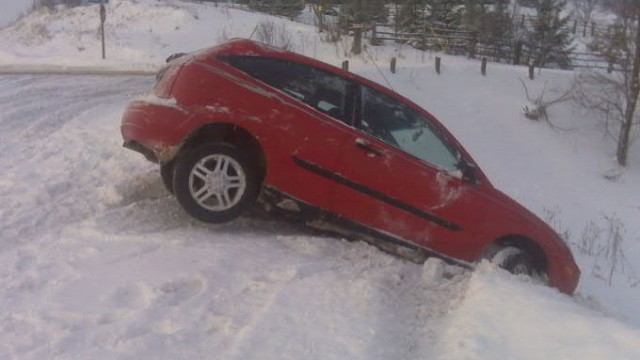
[…] a step-by step approach to safety, starting with an emergency kit (for more on that, go here)Now it’s time to talk about the rubber meeting the road…literally. There’s no […]
[…] is a no-brainer for my backpacking emergency kit(for your car, you might want to consider other options). To paraphrase Lee Iacocca, if you can find a better light, buy it! Share and […]
Good reminders for the upcoming season. From experience I’d add the following: Winter clothing – the gloves mentioned above are a good idea but I’d add – keep an old winter coat in the car along with a pair of old winter boots and maybe pants too. Sometimes you break down when you’re not in “expedition mode” already and if you need to exit the vehicle in a storm, when all you have on is your business clothes, you’ll be glad you had the extra clothes. Same thing for some sort of throw rug or an old foam sleeping pad – ever had to change a tire or work under or in the car in a pile of slushy snow? And don’t forget to have a pen/pencil and all your insurance info and phone numbers (towing service?) up-to-date. You’ll be needing those if heaven forbid you do skid off the road and/or into something. I’m sure others can speak from their own practical experience too…
[…] stuff…three restaurants in different styles, indoor heated parking (but you still need your emergency kit!), fitness/spa facilities, fireplaces…even all-day daycare! With studio, 1BR and 2BR […]
“nele”, thanks for the comments! The article was focused specifically on ski trips, but I absolutely agree with your thoughts, and hope other readers will follow your advice. The piece of carpet (anyone who doesn’t have one hanging around can pick up a floor mat, or a remnant at a carpet store for cheap money) is not only a great idea for crawling under your car or putting your knees on, but also to help get traction if you’ve got a spinning wheel. Just slide it under the edge of the tire from the direction you want to go, then start up gingerly…the tire starting to spin will usually pull it under the wheel and help you get traction. Sounds like if you DO slide off the road this winter, you’ll be all set…congratulations! And please keep up the comments…we really appreciate the feedback!
I’ve read the article . . .and every time I’m in the car now I think Geez . . . you haven’t taken those precautions from Davids post! I still have to put the extra bucket of window washer fluid in the trunk just in case I run out after a long drive . . .a 20 or a 50 dollar bill might be good to leave in the ash tray or glove compartment too . . . if it is not to tempting to grab and splurge at a lodge somewhere!